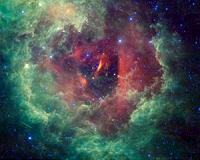 |
Baltimore MD (SPX) Aug 31, 2010 A website that brings the universe into the homes and onto the computer screens of professional and amateur astronomers alike has won a Science Prize for Online Resources in Education, known as SPORE, from the American Association for the Advancement of Science. Built by a Johns Hopkins University team led by astrophysicist and computer scientist Alexander Szalay, the SkyServer search tool of the Sloan Digital Sky Survey's database makes more than 350 million stars and galaxies available to students, teachers and the public. SkyServer's MapQuest-like interface allows them to pan through the sky, zoom in and out, and click on stars and galaxies for more information. "The Sloan Digital Sky Survey has made its entire dataset available through this online portal for public use in education," said Szalay, the Alumni Centennial Professor in the Krieger School's Henry A. Rowland Department of Physics and Astronomy. "This is a unique opportunity for students, teachers and the public to learn about astronomy. Basically, anyone with Internet access can now interact with the data in the same way that professional scientists do." The most ambitious astronomical survey ever taken, the Sloan Digital Sky Survey-which began in 1991 and involved hundreds of scientists around the world-is sometimes described as astronomy's equivalent of the Human Genome Project. When complete, it will provide detailed optical images covering more than a quarter of the sky, as well as a three-dimensional map of millions of galaxies and quasars. The development of SkyServer, in particular, benefited greatly from Szalay's collaboration with Jim Gray of Microsoft Research, who worked with the Johns Hopkins team on that and several other large-scale, high-performance scientific databases. The SDSS website gives browsers access to a three-dimensional map of the entire universe, including the brightest 1 million stars and quasars. This data is fed into the website by a dedicated 2.5 meter diameter SDSS telescope that uses a 120 megapixel camera in New Mexico to image the entire night sky, 1.5 square degrees of sky at a time (about eight times the area of the full moon). The goal of the survey is to address fundamental questions about the universe by looking at large-scale patterns of the galaxies. Astrophysicists have many theories about how the universe came into being and evolved, and the Sloan Digital Sky Survey is aimed at telling scientists which theories are correct, or whether they must come up with completely new ones. Using the SkyServer search tool, users can visually explore the heavens and sort through the reams of data available on the SDSS site, Szalay said. "SkyServer users can pan through the sky, zoom in and out, and click on stars and galaxies for more information, such as the galaxy's brightness or its position in the sky," Szalay said. "There also are tools that let any user examine SDSS data on any object. It's truly amazing." SkyServer also provides middle school, high school and college students with a series of suggested science projects, complete with Excel spreadsheet templates to make data analysis easier. Topics of the projects include understanding why stars have different colors, classifying stellar spectra and examining the expansion of the universe. These projects were designed by Johns Hopkins team member Jordan Raddick, who wrote about the educational value of the website in the Aug. 27 issue of Science, which announced the award. "SkyServer provides an opportunity for teachers, students and the public to learn about astronomy interactively, which we know from education research is extremely effective and important," Raddick said. "This website and its tools allow anyone with Internet access to interact with the SDSS data in the way real scientists do, which is remarkable." Over the last six years, the SDSS has been named several times as being among the most-used astronomy database facilities in the world, based upon an analysis of astronomy journal citations presented yearly at the meetings of the American Astronomical Society. "The bottom line is that this is the way astronomy is being done in the 21st century. Scientists don't have to compete for time on expensive telescopes-they simply dial up the sky on their computers," Szalay said. "It's wonderful to be recognized for our work on the SkyServer, but in truth this award reflects the amazing work of hundreds of astrophysicists and astronomers and computer scientists over the last two decades."
Share This Article With Planet Earth
Related Links SDSS SkyServer Space Telescope News and Technology at Skynightly.com
 WISE Captures The Unicorn's Rose
WISE Captures The Unicorn's RoseLos Angeles CA (SPX) Aug 27, 2010 Unicorns and roses are usually the stuff of fairy tales, but a new cosmic image taken by NASA's Wide-field Infrared Explorer (WISE) shows the Rosette nebula located within the constellation Monoceros, or the Unicorn. This flower-shaped nebula, also known by the less romantic name NGC 2237, is a huge star-forming cloud of dust and gas in our Milky Way galaxy. Estimates of the nebula's dista ... read more |
|
| The content herein, unless otherwise known to be public domain, are Copyright 1995-2010 - SpaceDaily. AFP and UPI Wire Stories are copyright Agence France-Presse and United Press International. ESA Portal Reports are copyright European Space Agency. All NASA sourced material is public domain. Additional copyrights may apply in whole or part to other bona fide parties. Advertising does not imply endorsement,agreement or approval of any opinions, statements or information provided by SpaceDaily on any Web page published or hosted by SpaceDaily. Privacy Statement |